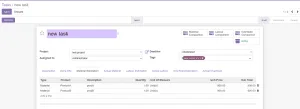HOW TO USE THIS MODULE
- Project Estimation Moduledepends AG_material_requisition module, so you need to install it initially.
- You need to give material requisition access to the user from the settings.
In the Employee Time-sheet, you will find a form view where you can enter essential details such as Date, Project, and Project-related tasks. The Time-sheet Details section includes a one2many field, allowing you to select multiple employees and specify the duration required to complete the specific task. After entering all the necessary information, you need to confirm the details, which will then change the status to confirmed.

Similarly, in the overhead time-sheet form, you can specify and input the actual quantities and costs of each product to be used in the tasks of the respective projects. Once you have entered the details, you can confirm them, transitioning the status to confirmed.
For material estimation, materials are requested through the requisition module. In this module, materials are requested for each project and task. If the required quantity is available, the products will be delivered and added to the stock. If the products are unavailable, a purchase tender will be generated, leading to the creation of a Request for Quotation (RFQ) and subsequent delivery of the items to the stock. The detailed functionality of this module is explained in the AG_material_requisition module.


Next, there is the overhead estimation section where you are required to specify the estimated overhead cost for this particular project.

The actual overhead cost is calculated based on the information provided in the Overhead Estimation form.

Once the actual and estimated materials, labor, and overheads have been accounted for, a comprehensive summary becomes available. This summary includes the total material estimate, total labor estimate, and total overhead estimate. The combined total is presented as the overall job estimation. Additionally, in the top right corner, there are smart buttons available for comparing the actual materials, labor, and overheads with the estimated materials, labor, and overheads.

In this section, the estimated quantity and value are 1 and 900, while the actual quantity and value are 9 and 8100 respectively. Therefore, the deviation in both quantity and value is calculated as the difference between the actual and estimated values, resulting in 8 units and 7200 in value.

The same comparison method applies to labor and overheads as well.






















 Afrikaans
Afrikaans Albanian
Albanian Amharic
Amharic Arabic
Arabic Armenian
Armenian Azerbaijani
Azerbaijani Basque
Basque Belarusian
Belarusian Bengali
Bengali Bosnian
Bosnian Bulgarian
Bulgarian Catalan
Catalan Cebuano
Cebuano Chichewa
Chichewa Chinese (Simplified)
Chinese (Simplified) Chinese (Traditional)
Chinese (Traditional) Corsican
Corsican Croatian
Croatian Czech
Czech Danish
Danish Dutch
Dutch English
English Esperanto
Esperanto Estonian
Estonian Filipino
Filipino Finnish
Finnish French
French Frisian
Frisian Galician
Galician Georgian
Georgian German
German Greek
Greek Gujarati
Gujarati Haitian Creole
Haitian Creole Hausa
Hausa Hawaiian
Hawaiian Hebrew
Hebrew Hindi
Hindi Hmong
Hmong Hungarian
Hungarian Icelandic
Icelandic Igbo
Igbo Indonesian
Indonesian Irish
Irish Italian
Italian Japanese
Japanese Javanese
Javanese Kannada
Kannada Kazakh
Kazakh Khmer
Khmer Korean
Korean Kurdish (Kurmanji)
Kurdish (Kurmanji) Kyrgyz
Kyrgyz Lao
Lao Latin
Latin Latvian
Latvian Lithuanian
Lithuanian Luxembourgish
Luxembourgish Macedonian
Macedonian Malagasy
Malagasy Malay
Malay Malayalam
Malayalam Maltese
Maltese Maori
Maori Marathi
Marathi Mongolian
Mongolian Myanmar (Burmese)
Myanmar (Burmese) Nepali
Nepali Norwegian
Norwegian Pashto
Pashto Persian
Persian Polish
Polish Portuguese
Portuguese Punjabi
Punjabi Romanian
Romanian Russian
Russian Samoan
Samoan Scottish Gaelic
Scottish Gaelic Serbian
Serbian Sesotho
Sesotho Shona
Shona Sindhi
Sindhi Sinhala
Sinhala Slovak
Slovak Slovenian
Slovenian Somali
Somali Spanish
Spanish Sundanese
Sundanese Swahili
Swahili Swedish
Swedish Tajik
Tajik Tamil
Tamil Telugu
Telugu Thai
Thai Turkish
Turkish Ukrainian
Ukrainian Urdu
Urdu Uzbek
Uzbek Vietnamese
Vietnamese Welsh
Welsh Xhosa
Xhosa Yiddish
Yiddish Yoruba
Yoruba Zulu
Zulu
Reviews
There are no reviews yet.